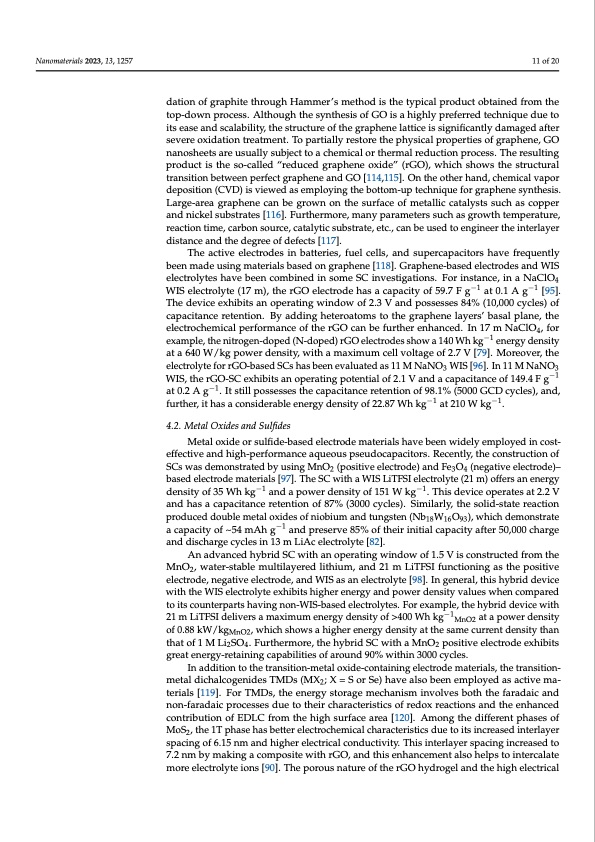PDF Publication Title:
Text from PDF Page: 011
Nanomaterials 2023, 13, 1257 11 of 20 dation of graphite through Hammer’s method is the typical product obtained from the top-down process. Although the synthesis of GO is a highly preferred technique due to its ease and scalability, the structure of the graphene lattice is significantly damaged after severe oxidation treatment. To partially restore the physical properties of graphene, GO nanosheets are usually subject to a chemical or thermal reduction process. The resulting product is the so-called “reduced graphene oxide” (rGO), which shows the structural transition between perfect graphene and GO [114,115]. On the other hand, chemical vapor deposition (CVD) is viewed as employing the bottom-up technique for graphene synthesis. Large-area graphene can be grown on the surface of metallic catalysts such as copper and nickel substrates [116]. Furthermore, many parameters such as growth temperature, reaction time, carbon source, catalytic substrate, etc., can be used to engineer the interlayer distance and the degree of defects [117]. The active electrodes in batteries, fuel cells, and supercapacitors have frequently been made using materials based on graphene [118]. Graphene-based electrodes and WIS electrolytes have been combined in some SC investigations. For instance, in a NaClO4 WIS electrolyte (17 m), the rGO electrode has a capacity of 59.7 F g−1 at 0.1 A g−1 [95]. The device exhibits an operating window of 2.3 V and possesses 84% (10,000 cycles) of capacitance retention. By adding heteroatoms to the graphene layers’ basal plane, the electrochemical performance of the rGO can be further enhanced. In 17 m NaClO4, for example, the nitrogen-doped (N-doped) rGO electrodes show a 140 Wh kg−1 energy density at a 640 W/kg power density, with a maximum cell voltage of 2.7 V [79]. Moreover, the electrolyte for rGO-based SCs has been evaluated as 11 M NaNO3 WIS [96]. In 11 M NaNO3 WIS, the rGO-SC exhibits an operating potential of 2.1 V and a capacitance of 149.4 F g−1 at 0.2 A g−1. It still possesses the capacitance retention of 98.1% (5000 GCD cycles), and, further, it has a considerable energy density of 22.87 Wh kg−1 at 210 W kg−1. 4.2. Metal Oxides and Sulfides Metal oxide or sulfide-based electrode materials have been widely employed in cost- effective and high-performance aqueous pseudocapacitors. Recently, the construction of SCs was demonstrated by using MnO2 (positive electrode) and Fe3O4 (negative electrode)– based electrode materials [97]. The SC with a WIS LiTFSI electrolyte (21 m) offers an energy density of 35 Wh kg−1 and a power density of 151 W kg−1. This device operates at 2.2 V and has a capacitance retention of 87% (3000 cycles). Similarly, the solid-state reaction produced double metal oxides of niobium and tungsten (Nb18W16O93), which demonstrate a capacity of ~54 mAh g−1 and preserve 85% of their initial capacity after 50,000 charge and discharge cycles in 13 m LiAc electrolyte [82]. An advanced hybrid SC with an operating window of 1.5 V is constructed from the MnO2, water-stable multilayered lithium, and 21 m LiTFSI functioning as the positive electrode, negative electrode, and WIS as an electrolyte [98]. In general, this hybrid device with the WIS electrolyte exhibits higher energy and power density values when compared to its counterparts having non-WIS-based electrolytes. For example, the hybrid device with 21 m LiTFSI delivers a maximum energy density of >400 Wh kg−1MnO2 at a power density of 0.88 kW/kgMnO2, which shows a higher energy density at the same current density than that of 1 M Li2SO4. Furthermore, the hybrid SC with a MnO2 positive electrode exhibits great energy-retaining capabilities of around 90% within 3000 cycles. In addition to the transition-metal oxide-containing electrode materials, the transition- metal dichalcogenides TMDs (MX2; X = S or Se) have also been employed as active ma- terials [119]. For TMDs, the energy storage mechanism involves both the faradaic and non-faradaic processes due to their characteristics of redox reactions and the enhanced contribution of EDLC from the high surface area [120]. Among the different phases of MoS2, the 1T phase has better electrochemical characteristics due to its increased interlayer spacing of 6.15 nm and higher electrical conductivity. This interlayer spacing increased to 7.2 nm by making a composite with rGO, and this enhancement also helps to intercalate more electrolyte ions [90]. The porous nature of the rGO hydrogel and the high electricalPDF Image | Water-in-Salt Eutectic Solvent-Based Liquid Electrolytes

PDF Search Title:
Water-in-Salt Eutectic Solvent-Based Liquid ElectrolytesOriginal File Name Searched:
nanomaterials-13-01257.pdfDIY PDF Search: Google It | Yahoo | Bing
Salgenx Redox Flow Battery Technology: Power up your energy storage game with Salgenx Salt Water Battery. With its advanced technology, the flow battery provides reliable, scalable, and sustainable energy storage for utility-scale projects. Upgrade to a Salgenx flow battery today and take control of your energy future.
CONTACT TEL: 608-238-6001 Email: greg@infinityturbine.com (Standard Web Page)